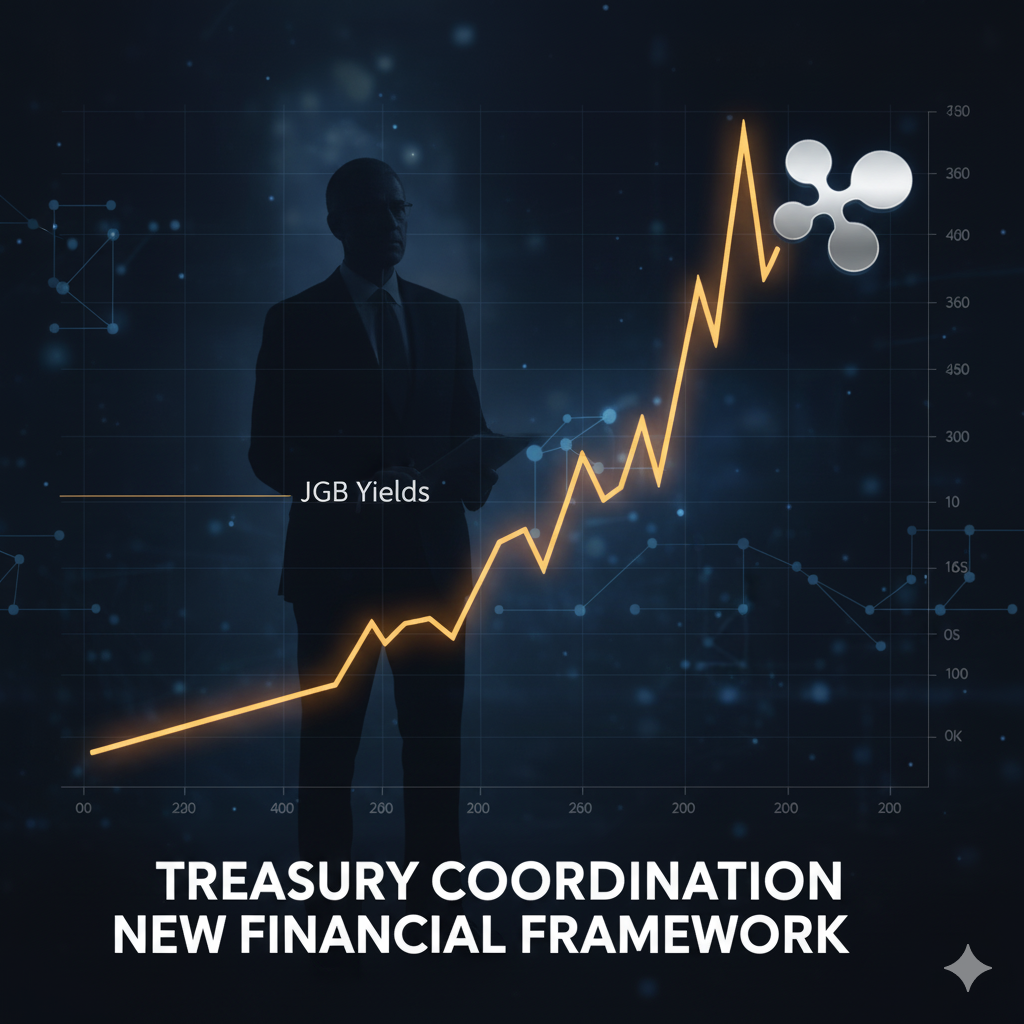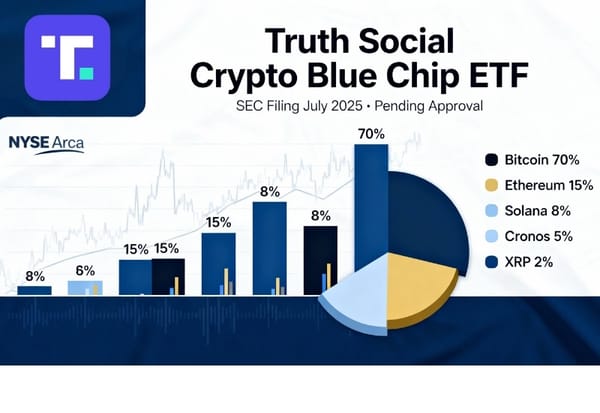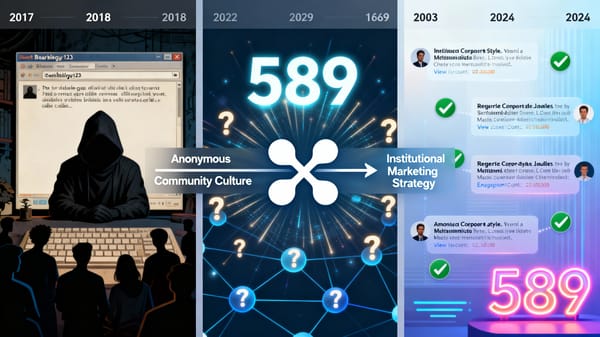Japan's Bond Crisis: The First Domino Falls in Claver's XRP Theory
Japan's new PM Sanae Takaichi triggers bond market chaos as yields spike to record highs. Goldman warns of global spillover. Is this Jake Claver's XRP Domino Theory playing out? Treasury Secretary Bessent watches closely as 80% of Japanese banks prepare for XRP adoption. The first domino falls.

Japan's new Prime Minister triggers bond market chaos as Treasury Secretary Bessent watches closely—could this spark the financial cascade that propels XRP to mainstream adoption?
Financial strategist Jake Claver's "XRP Domino Theory" may be playing out in real-time as Japan's bond market experiences unprecedented volatility following Sanae Takaichi's surprise election as the country's first female Prime Minister. The development has sent shockwaves through global markets and raised critical questions about the future of cross-border payments and digital asset adoption.
The Japan Crisis Unfolds
Takaichi's victory on October 4, 2025, immediately rattled financial markets. Japan's 30-year bond yields surged over 13 basis points to 3.291%, hovering near all-time highs as investors braced for her pro-stimulus fiscal agenda combined with continued dovish monetary policy from the Bank of Japan.
Goldman Sachs warned that volatility in Japan's longer-dated government bonds would spill over to global markets, with every 10 basis point move in Japanese Government Bonds (JGBs) translating to 2-3 basis points of upward pressure on US, German, and UK yields. This interconnection makes Japan's $8 trillion bond market a critical concern for global financial stability.
Enter Scott Bessent: Strategic Coordination
US Treasury Secretary Scott Bessent has maintained unusually close coordination with Japan throughout 2025. His first official call as Treasury Secretary was with Japanese Finance Minister Katsunobu Kato on January 28, 2025, signaling Japan's strategic importance to US economic policy.
This relationship takes on new significance in light of Takaichi's election. Bessent's engagement with Japan goes beyond typical diplomatic courtesy—it suggests active management of systemic financial risks that could impact US Treasury markets.
Breaking: The Argentina Precedent
Just yesterday (October 9, 2025), Bessent demonstrated exactly this capability in dramatic fashion. The US Treasury directly purchased Argentine pesos and finalized a $20 billion currency swap framework with Argentina's central bank in a rare intervention to stabilize the country's collapsing currency.
"The US Treasury is prepared, immediately, to take whatever exceptional measures are warranted to provide stability to markets," Bessent announced on social media. The peso had been in freefall, and Argentina faced acute liquidity pressure ahead of its October 26 elections.
This intervention is unprecedented in several ways:
- Direct Currency Purchase: The US Treasury bought pesos in the open market—a move financial specialists called "unheard of"
- Use of Exchange Stabilization Fund (ESF): Bessent deployed the Treasury's $221 billion ESF, which operates without Congressional approval
- Political Support for Aligned Leader: Clear support for President Javier Milei, demonstrating willingness to backstop ideologically aligned governments
- Proof of Capability: Showed the US can and will intervene unilaterally in foreign currency markets
The timing is remarkable: Bessent intervened in Argentina's peso crisis on October 9, just five days after Japan's bond market chaos began on October 4. This isn't coincidence—it's a demonstration of the framework in action.
The "Digital Gold Standard" Framework: From Argentina to Japan
The Argentina intervention provides the blueprint for understanding what could happen with Japan, but at a vastly different scale:
Argentina (Tier 2 - Small Economy Proof-of-Concept)
- $20 billion swap line
- Direct peso purchases in open market
- Unilateral US action using ESF
- Emerging market, $640 billion GDP
- Political support for aligned leader
- Purpose: Demonstrate capability to stabilize allied currencies
Japan (Tier 1 - G7 Scale-Up - Potential)
- Coordinated Fed-BOJ swap line expansion (existing infrastructure)
- Joint yield curve management for JGB market
- Bilateral cooperation, not unilateral
- G7 economy, $4.2 trillion GDP, $8 trillion bond market
- Strategic ally with direct US Treasury market impact
- Purpose: Demonstrate scalability to major economies
The difference is sophistication. Argentina got direct intervention—buy pesos, stabilize currency, done. Japan would get something far more elegant: coordinated monetary policy that makes attacking JGBs unprofitable because it means fighting both the Fed and BOJ simultaneously.
This is where XRP becomes relevant. If the US is willing to deploy capital to stabilize Argentina's small economy, and coordinate policy with Japan's massive economy, the infrastructure being built assumes frictionless, real-time cross-border settlement. Traditional correspondent banking cannot keep pace with this level of coordination. Digital assets designed for institutional settlement—like XRP—become the natural rails for this "digital gold standard" framework.
Jake Claver's Domino Theory: From Prediction to Reality
Jake Claver, CEO of Digital Ascension Group and a prominent family office strategist, outlined his "XRP Domino Theory" predicting a specific sequence of financial events:
Domino #1: Japan & The Digital Yen - Japan developing its CBDC while potentially reducing US Treasury holdings as domestic investment becomes more attractive through digital currency infrastructure.
Domino #2: US Treasury Market Stress - Japanese institutional withdrawal from US debt creating pressure on Treasury yields and potentially triggering broader market instability.
Domino #3: Stablecoin Instability - Particularly targeting Tether (USDT), as regulatory pressure and Treasury market stress could undermine confidence in dollar-backed stablecoins.
Domino #4: Cryptocurrency Market Impact - Bitcoin and other major cryptocurrencies experiencing volatility as the carry trade unwinds and traditional financial infrastructure shows cracks.
Domino #5: XRP Emerges as Essential Infrastructure - Rather than remaining a speculative asset, XRP becomes critical payment infrastructure as traditional systems prove inadequate.
The current crisis fits perfectly into Claver's framework. Japan's bond market stress is creating exactly the conditions he predicted would force a systemic reevaluation of cross-border payment infrastructure.
The Reverse Carry Trade Connection
The carry trade—borrowing cheap yen to invest in higher-yielding assets—has been unwinding since the Bank of Japan raised rates from -0.1% to 0.5%. Estimates suggest the yen carry trade could be worth between $1.1 trillion and $4 trillion, making its reversal a major liquidity event.
When Takaichi's fiscal expansion plans combine with BOJ rate normalization, it accelerates this unwinding. The stronger yen makes yen-denominated borrowing more expensive, forcing investors to unwind positions across global markets. This creates exactly the kind of financial stress that could drive institutional adoption of more efficient payment rails.
XRP/Ripple Analysis: Positioned for the Perfect Storm
Japan's crisis creates multiple tailwinds for XRP adoption:
Institutional Infrastructure Already in Place
Reports indicate that by 2025, nearly 80% of Japan's banks will integrate XRP into their systems for cross-border payments and remittances. SBI Holdings CEO Yoshitaka Kitao has been a vocal advocate for XRP as the optimal solution for international transfers, particularly crucial for Japan's large migrant worker population.
Japan's $6.37 Trillion Banking Market
With Japan's banking industry valued at $6.37 trillion, XRP adoption in this market would represent massive liquidity inflow. Major institutions including Mitsubishi UFJ, Sumitomo Mitsui, and Mizuho currently process billions in daily transactions through slow, expensive systems like SWIFT. XRP offers settlement in 3-5 seconds versus days for traditional banking.
The "Digital Gold Standard" Framework
The Argentina intervention earlier in 2025 proved the US Treasury could stabilize small allied currencies. Japan represents the next level: proof that dollar-stability infrastructure can scale to G7 economies. If Bessent coordinates with the Bank of Japan to manage JGB volatility through expanded swap line usage, it would demonstrate algorithmic coordination at a sophisticated level.
This creates an environment where XRP's efficiency becomes not just attractive, but necessary. Traditional correspondent banking can't compete when Treasury markets are volatile and currency movements are unpredictable.
Price Implications
While speculation about XRP reaching $2,000 (as Claver has suggested for early 2026) may seem aggressive, the fundamental drivers are aligning:
- Institutional Demand: Japanese banks adopting XRP for actual payment flows, not speculation
- Regulatory Clarity: XRP's legal status as non-security in the US removes major uncertainty
- Macro Stress: Bond market volatility and carry trade unwinding creating demand for alternative settlement methods
- Network Effects: Japan adoption could cascade to other G7 nations seeking similar efficiency
More conservative analysts suggest that full banking adoption in Japan alone could drive XRP toward the $10-$50 range based on actual transaction volume requirements.
Ripple's Strategic Position
Ripple has methodically built relationships with central banks and financial institutions for years. The current crisis validates their approach. RippleNet and On-Demand Liquidity (ODL) solutions offer exactly what stressed financial systems need: real-time settlement with minimal counterparty risk.
SBI Holdings' plans to launch a Bitcoin and XRP ETF in Japan further legitimizes XRP as an institutional asset class, not merely a speculative token.
Market Implications and Risks
The convergence of these factors creates both opportunity and danger:
Upside Scenario: Bessent coordinates with Japan, preventing bond market chaos. This coordination includes facilitating XRP adoption for yen-dollar settlement, proving the "digital gold standard" framework. Other nations follow Japan's lead, creating network effects that drive genuine XRP demand.
Downside Scenario: Japan's bond market spirals without effective intervention, triggering broader deleveraging. Carry trade unwinding accelerates, creating indiscriminate selling across all risk assets including crypto. XRP falls despite fundamentals as macro conditions overwhelm micro factors.
Most Likely Scenario: Gradual coordination between US and Japanese authorities, with quiet expansion of swap line usage and encouragement of private-sector payment innovation. XRP adoption accelerates in Japan not through government mandate but through practical necessity as traditional rails prove inadequate during volatility.
What to Watch
Critical signals over the next 30-60 days:
- Argentina Outcome: Whether the October 9 peso intervention successfully stabilizes Argentina through their October 26 elections—this tests the framework's effectiveness
- Bessent Statements on Japan: Any public comments about JGB market or financial stability coordination with Japan (especially in light of Argentina action)
- Fed-BOJ Swap Lines: Weekly Fed balance sheet data showing swap line activations
- XRP Adoption Metrics: Announcements from Japanese banks about ODL implementation timelines
- JGB Yield Movements: If 30-year JGB yields break above 3.5%, intervention probability increases significantly
- Stablecoin Developments: Any regulatory action or redemption stress on major stablecoins like USDT
- Congressional Response: US lawmakers' reaction to Argentina intervention—several Democratic Senators already introduced the "No Argentina Bailout Act" to prevent ESF use
Conclusion
Jake Claver's Domino Theory may be transitioning from speculation to reality. Japan's bond market crisis is creating exactly the systemic stress he predicted would force reevaluation of global payment infrastructure.
What makes this moment extraordinary is the timing: Bessent intervened in Argentina's currency crisis on October 9—just five days after Japan's bond turmoil began. This dual-track approach demonstrates both capability (Argentina) and intent (Japan coordination). With Scott Bessent actively coordinating with Japanese authorities and 80% of Japanese banks planning XRP integration, the pieces are aligning for a major shift in how international finance operates.
The Argentina intervention proves Bessent will act decisively to stabilize aligned nations' currencies using tools that don't require Congressional approval. Japan represents the next test: can this framework scale from a $640 billion emerging market to an $8 trillion G7 bond market?
The question isn't whether traditional correspondent banking is obsolete—it's whether the transition to blockchain-based settlement will be orderly or chaotic. XRP's positioning in Japan, combined with US Treasury support for financial stability, suggests the infrastructure for orderly transition is being built in real-time.
For investors, the key is distinguishing between short-term volatility driven by macro deleveraging and long-term structural adoption driven by genuine utility. Japan's crisis may create both, making this a pivotal moment for XRP's evolution from speculative asset to essential infrastructure.
DISCLAIMER: This newsletter is for informational purposes only and does not constitute investment advice, advertising, or a recommendation to buy, sell, or hold any securities. This content is not sponsored by or affiliated with any of the mentioned entities. Investments in cryptocurrencies or other financial assets carry significant risks, including the potential for total loss, extreme volatility, and regulatory uncertainty. Past performance is not indicative of future results. Always consult a qualified financial professional and conduct thorough research before making any investment decisions.
Sources
- CNN Business: "Bessent says US purchased pesos and finalized framework for $20 billion lifeline for Argentina" - October 9, 2025
- CNBC: "Trump boosts Argentina's Milei with $20 billion lifeline as U.S. buys pesos" - October 9, 2025
- Buenos Aires Herald: "US Treasury intervenes directly in Argentine forex market" - October 9, 2025
- CNBC: "Japan's bond vigilantes brace for looser fiscal stance after Sanae Takaichi wins party vote" - October 6, 2025
- Goldman Sachs via Yahoo Finance: "Goldman Sees Japan Bond 'Shocks' Spilling Over to Treasuries" - October 6, 2025
- US Department of Treasury: "READOUT: Secretary of the Treasury Scott Bessent's Call with Japanese Finance Minister Katsunobu Kato" - January 28, 2025
- Times Tabloid: "XRP Domino Theory: What Does It Mean? Details" - March 17, 2025
- Nasdaq: "80% of Japanese Banks Set to Embrace XRP for Global Payments by 2025"
- Finance Magnates: "Why Japan's Rate Hike Could Reshape Global Flows — and New Bitcoin Rally" - July 28, 2025
- Globe Newswire: "Bank of Japan Adopts XRP – What This Means for BlocScale, XRP's First IDO Launchpad" - February 26, 2025
- CryptoNews: "XRP Price Prediction: Japan's First Bitcoin-XRP ETF Set to Launch" - August 7, 2025
- Bloomberg: "Takaichi Win Jolts Yen and Japanese Bonds, Triggers Stock Surge" - October 5, 2025
- The Japan Times: "U.S. Treasury Secretary Bessent to visit Japan next week for Expo" - July 9, 2025



